Articles & Videos
Maths made fun: Game ideas using Maths Trek’s interactive tools
Categories
Subscribe to our newsletters
Receive teaching resources and tips, exclusive special offers, useful product information and more!
Maths made fun: Game ideas using Maths Trek’s interactive tools
Maths Trek 12/2/24
Maths Trek has four interactive tools: a Hundreds chart, a Place value chart, a Spinner and a Clock. The tools are embedded throughout the program to help you teach the concepts, and come preset ready to use in the lesson. But did you know you can also navigate to, and configure, these versatile tools yourself to use for fun games and warm-up activities? We’ve compiled a few game ideas for each tool to get you started.
Hundreds Chart
Find it first
Players: Whole class, split into two teams
Aim of the game: To score the most points by identifying numbers on the hundreds chart.
How to play:
- A student from each team stands on either side of the hundreds chart.
- Call out a number from the chart.
- The two students race to be the first to find the number on the chart and point to it.
- The fastest student earns a point for their team.
- Two new students take their place and a new number is called to continue the game.
- The team with the most points wins.
Variation: Make the game more difficult by describing the number using place value clues (e.g. 4 tens and 2 ones), or calling sums (e.g. 6 x 7) for students to find the answer on the chart. Remind the audience not to call out answers.
Number hunt
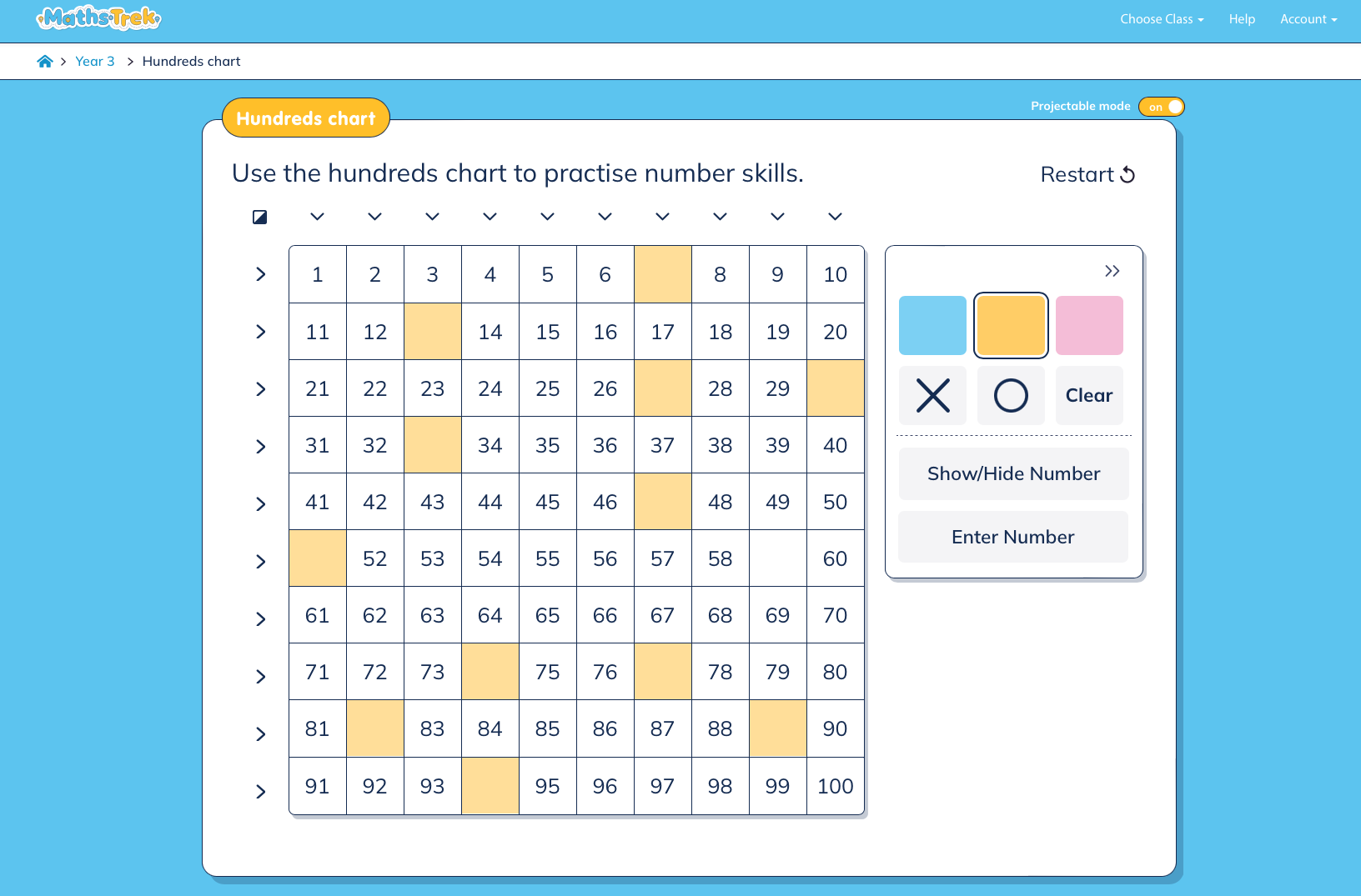
Players: Whole class
Aim of the game: To complete the hundreds chart.
How to play:
- Display the hundreds chart with numbers missing (pre-set) and hide sticky notes marked with the missing numbers around the room.
- Students search the room to find the numbers and then stick them in the correct place to complete the chart.
Tip: For younger students, choose to do the finding and the sticking separately. Or call on individuals or pairs to find and stick (so there’s less congestion in front of the board).
Variations:
- Make this activity easier by having students simply match the numbers to those already on the board; or harder by concealing extra numbers or leaving the chart completely blank.
- Have numbers missing from certain rows or columns to highlight counting patterns.
- Instead of hiding the numbers around the room to stick on the chart, students can use mini whiteboards to write down the missing numbers.
Skip to the finish
Players: Whole class, split into teams
Aim of the game: To be the first team to reach their target number.
How to play:
- Divide the class into teams and assign them a counting pattern (e.g. twos, threes, fives).
- Give each team a ten-sided dice and have teams take turns to roll their dice.
- Each time a team rolls their assigned number (i.e. the twos team rolls a 2), they move forward by that number on the hundreds chart.
- The target number is ten times their original number (e.g. the twos team’s target is 20, the tens team’s target is 100).
- Each team highlights their progress on the hundreds chart.
- The first team to reach their target number wins.
Variations:
- Use any counting patterns starting between 1 and 10.
- Skip count backwards by starting at the tenth number in the counting pattern.
Place Value Chart
Last number standing
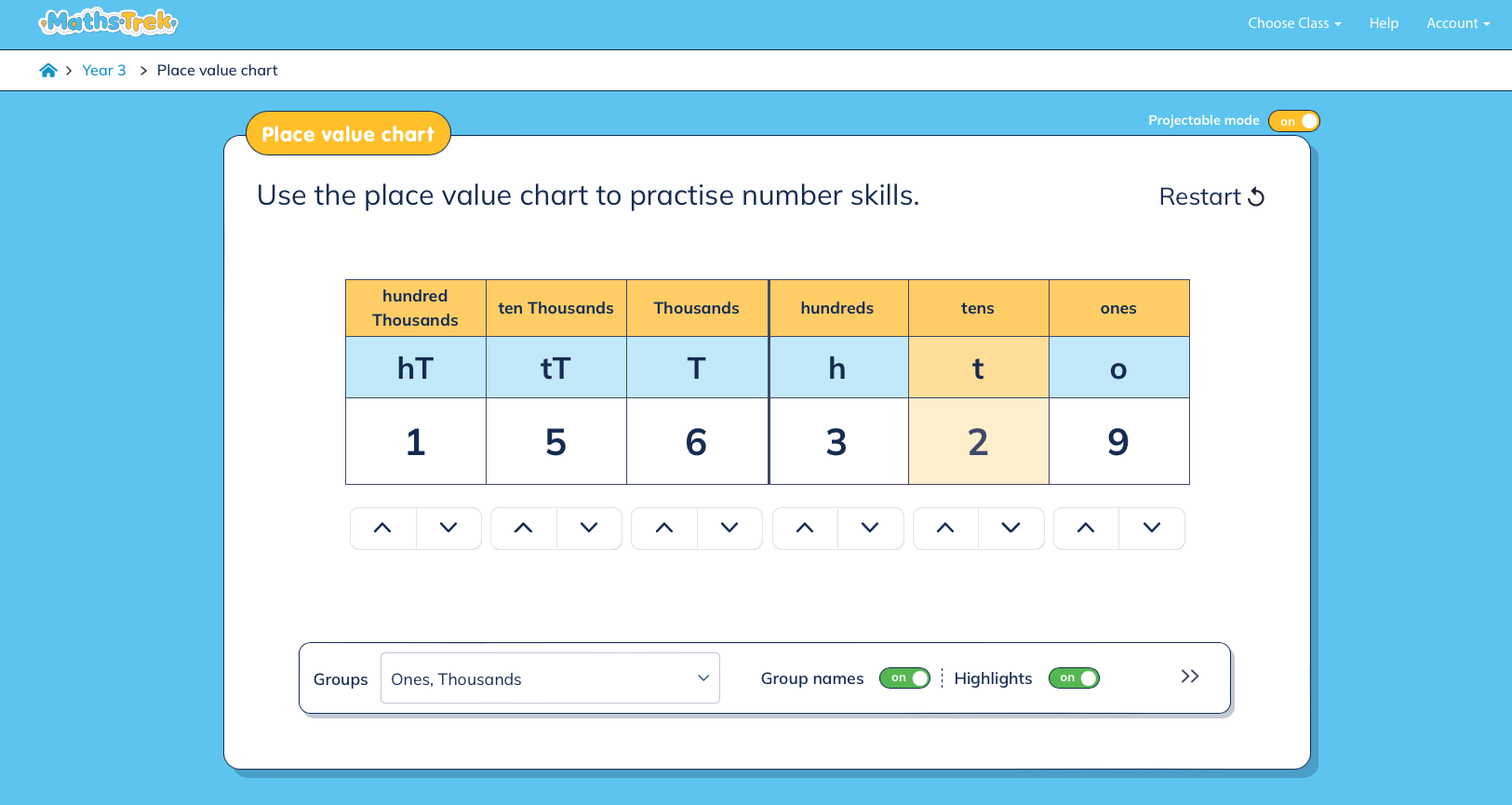
Players: Whole class
Aim of the game: To be the last person standing.
How to play:
- Students stand and write a number on a mini whiteboard (the size of the number depends on the year level).
- Display the place value chart on the board, enter a digit in one of the columns and call it out. If a student matches that value in their number, they have to sit down (e.g. sit down if you have a 5 in the tens column).
- Continue writing new numbers on the chart and calling them out.
- The winner is the last person standing.
Tip: Each time a student sits down, have them read out their number and identify the values in their number (e.g. ‘I had 452 which is 4 hundreds, 5 tens and 2 ones’).
Number bust
Players: Whole class
Aim of the game: To create the target number without going bust.
How to play:
- Choose a goal number (e.g. 10 000) and display a number lower than that on the place value chart (e.g. 8759).
- Roll a dice and call out the number.
- Students add this number to one of the place value columns (their choice) and write down their new number (e.g. using 8759, if you rolled a 2, students could add it in the hundreds column to make 8959, or in the ones column to make 8761).
- Continue rolling the dice, with students adding each number until everyone goes bust (goes past the goal number), or someone reaches the exact goal number.
Variations:
- This game can be played with any size numbers that are appropriate for your students.
- For an added challenge, you can also include decimal places.
- Choose to play until one person has the number closest to the target after 10 rolls.
Spinner
Greedy Gulls
Players: Whole class
Aim of the game: To create the largest number possible.
How to play:
- Students stand while you use the spinner to generate a number (preset the number range on the spinner to be relevant to student ability; you must include the number 1 at least once).
- Students write the number on a piece of paper or mini whiteboard.
- Spin another number and students add that number to the previous one.
- Students then choose: sit down with their current total or remain standing and keep playing.
- If you spin a 1, then everyone left standing has their number cleared to zero and the game ends.
- The winner is either the last person standing, or the student/s sitting with the largest number.
Rubbish bin numbers
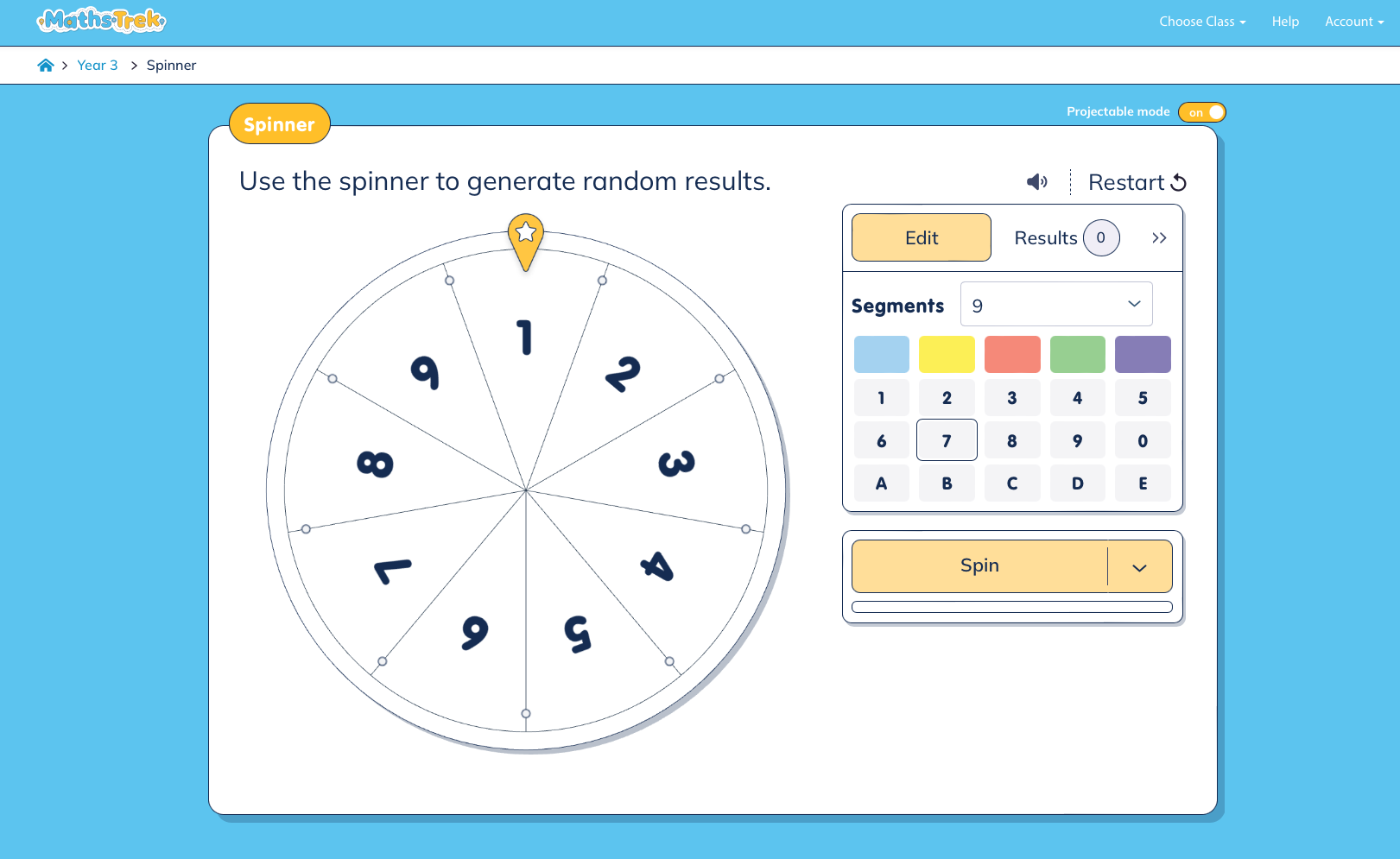
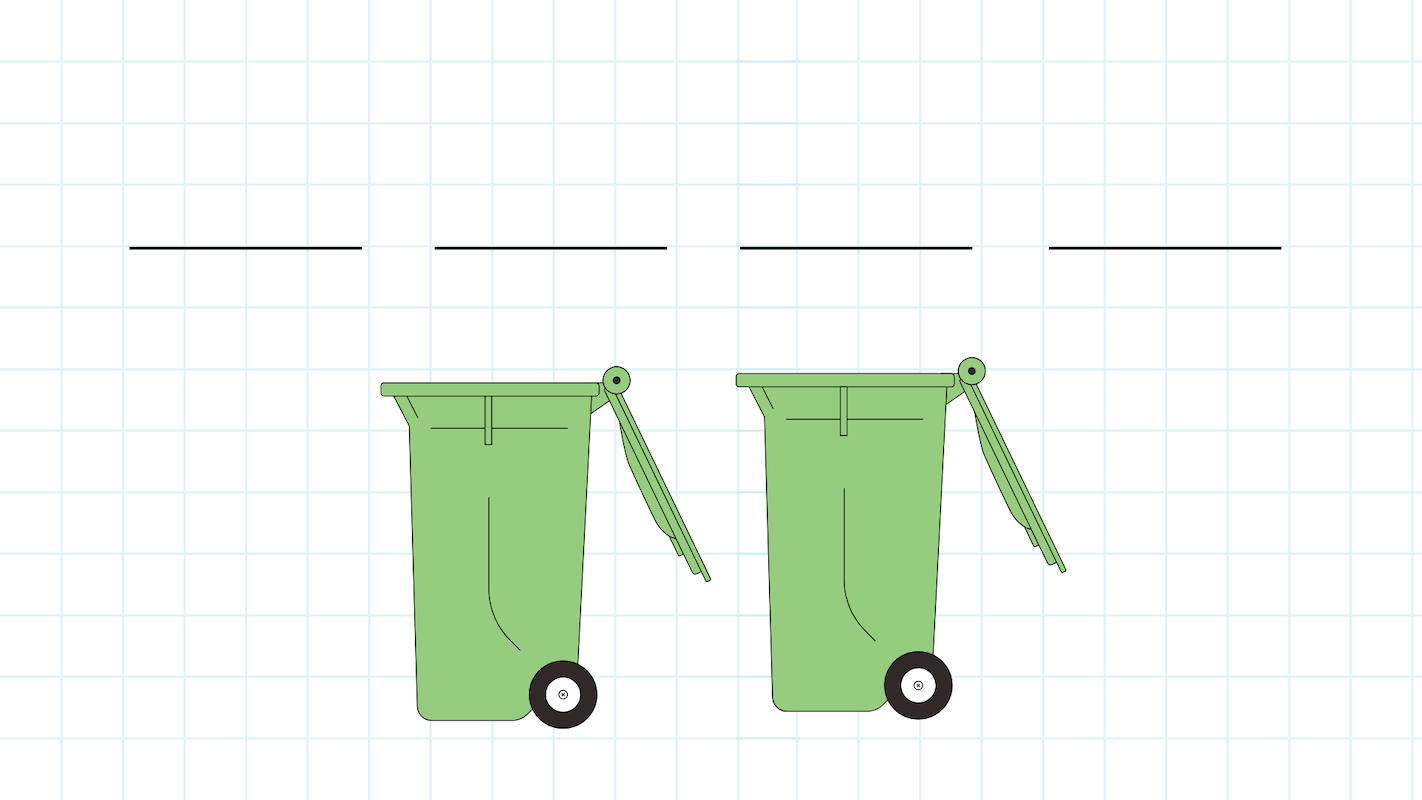
Players: Whole class
Aim of the Game: To create the largest number possible.
How to play:
- Students draw place value columns (e.g. thousands, hundreds, tens and ones) and two ‘rubbish bins’ on their paper or mini whiteboard.
- Use the spinner to generate a number from 0–9.
- Students decide where to write the number, either in a column on their place value chart, or in a rubbish bin (if they don’t wish to use that number). They can only discard one number in each bin and they can’t erase a number once it is written.
- Continue to spin numbers until the chart is full.
- The person who has made the highest number is the winner.
Tip: Generate discussion with students about the importance of place value, the size of each number, and chance, when deciding where to place each number.
Variations:
- This game can be played with any size numbers that are appropriate for your students, from 2 digit numbers upwards.
- Students can also try to create the smallest number possible, or you could remove the rubbish bins, and just spin numbers until the place value columns are filled.
- Have students try to beat the teacher – instead of ‘largest number wins’, the goal is simply to make a number bigger than the teacher’s.
Clock
Telephone time
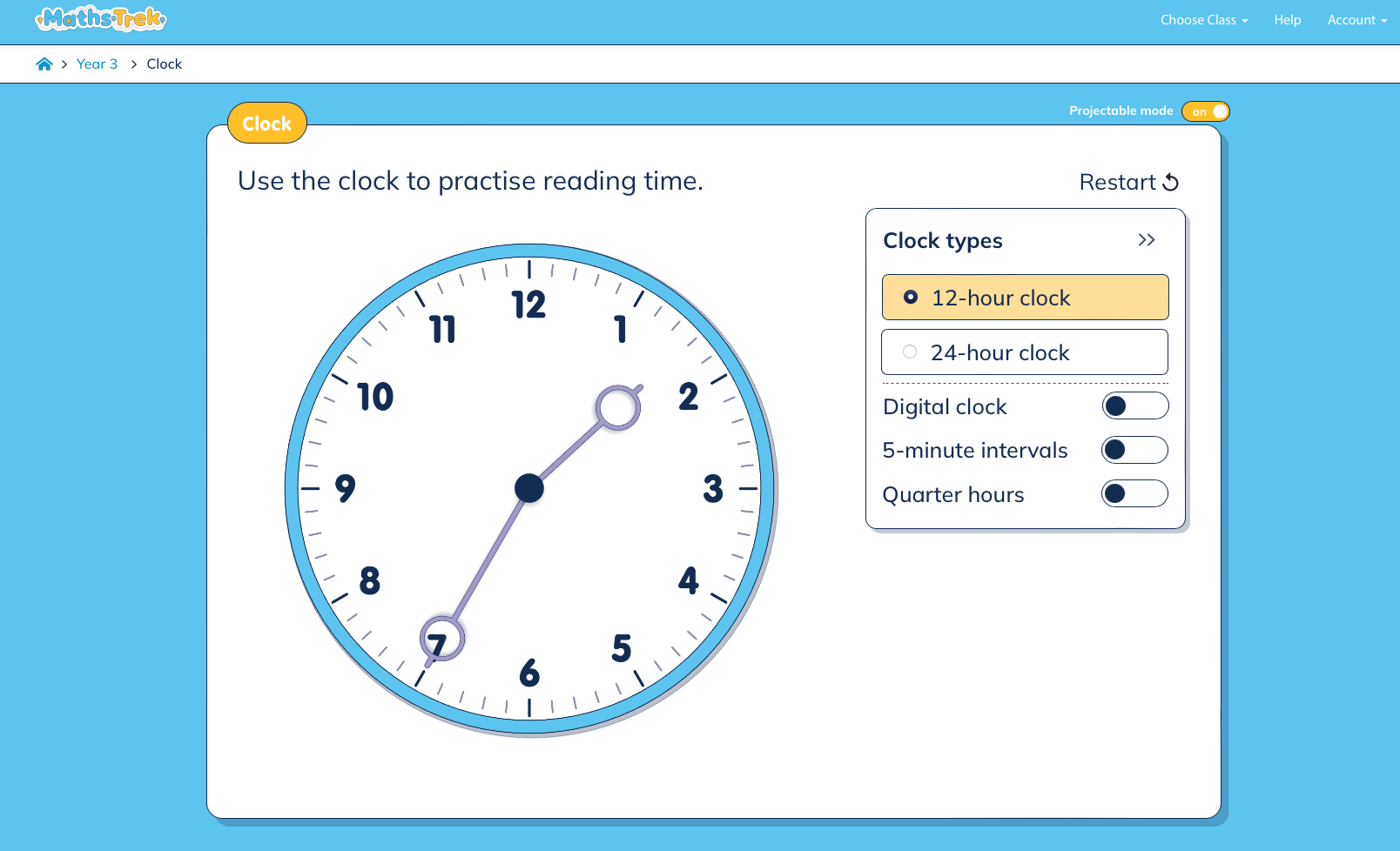
Players: Whole class, split into equally-numbered teams
Aim of the game: To be the first team sitting with the correct time displayed on their whiteboard.
How to play:
- Students stand in their team lines facing away from the board (and towards you). The person at the end of the line (and closest to the board) turns around to face the board.
- Display a time on the clock.
- The student facing the board in each team reads the time (silently), then turns to the next person in their team and whispers it to them. The time is whispered from person to person, along the line.
- When the time is whispered to the student at the front of the line (closest to you), they write the time on a mini whiteboard or piece of paper.
- The team then sits down to show they have an answer and the leader holds the mini whiteboard in the air to be checked. After each turn, the person at the front of the line moves to the end to face the board before the next time is displayed.
Variations:
- Ask students to write the time in words, in digital format or draw a clock face.
- Use teaching clocks instead of whiteboards to show the time.
What’s the time?
Players: Whole class, 4 students per turn
Aim of the game: To be the first player to touch the board at the front of the room.
How to play:
- Select a group of 4 students to play. Have those students line up at the back of the classroom facing the board.
- Display a time on the clock. The first student to correctly call the time out loud takes numbered steps towards the board to match the hours of the given time (i.e. if the time shown and called is 4:45, they take four steps).
- Play continues until a student touches the board.
Tip: Get as granular as you need with this game. For example, use times such as 6.28 or even ask students to phrase the time as ‘quarter to’ or ‘quarter past’.
These are just some of the ways you can use the Maths Trek interactive tools in your classroom. If you have other game or activity ideas, let us know about them!